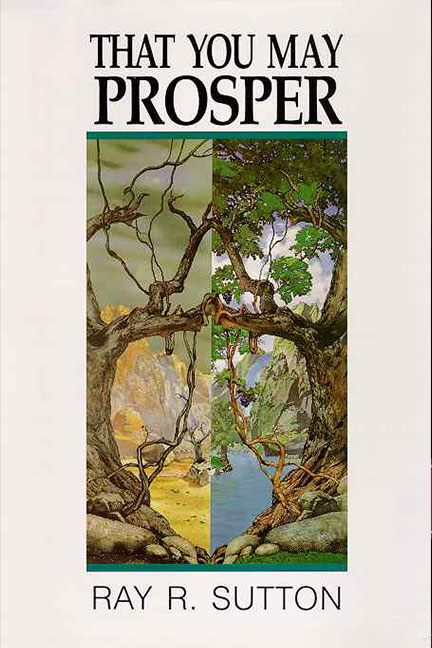
Appendix 10: The Covenant Structure of the Thirty-Nine Articles
Ray Sutton
Narrated By: Devan Lindsey
Book: That You May Prosper
Topics: Doctrinal Studies
Library: Gary North Library
Subscribe to the Audiobook
iTunes Spotify RSS FeedChapter Text
The Thirty-Nine Articles are the official doctrinal statement of the Anglican Church. Written by Thomas Cranmer, they were adopted in final form in 1571. They have not significantly been changed since then, although the prayer book has undergone some minor revisions. They have survived the “isms” of Twentieth Century better than any other doctrinal statement coming out of the Reformation.
The Thirty-Nine Articles are consciously or unconsciously marked by the theology of the Reformation, what Perry Miller calls “Federal theology.” How do I know? The articles logically break down according to the five-fold model of the covenant. Rev. John Howe, rector of Truro Episcopal Church in Fairfax, Virginia, in Our Anglican Heritage, says they may be grouped in five sections:
1-5 (The Trinity)
5-8 (Authority)
9-18 (Judicial Theology)
19-36 (The Sacraments)
37-39 (Property)[1]
The words in parenthesis are Howe’s; they are part of fuller explanations in his section on the Thirty-Nine Articles. His words use some of the same terminology that I have utilized to explain the covenant, certainly without any prompting from me. His book has been out for nearly ten years.
As far as I know, Howe’s division of the Thirty-Nine Articles would be generally accepted. The structure is quite obvious because the subject matter shifts at logical points. But let us consider the emphasis of each section in light of the covenant structure. I think we will see fairly easily without forcing them that the sections of the Thirty-Nine Articles parallel the covenant model, making them a covenant document.
The Covenant Structure of the Thirty-Nine Articles
1-5 (Transcendence): Section one begins, “There is but one living and true God.” The articles open with a discussion of the Trinity and the Incarnation. Could there be any clearer reference to the first point of covenantalism: transcendence? These articles describe God and who He is. They note His transcendence as well as His immanence.
5-8 (Hierarchy): The next section focuses on Holy Scripture and the creeds. These are the authorities of the Church. It should be mentioned that article seven briefly describes the relationship between Old and New Testament and in this context talks about the law. But the emphasis is not so much on law as it is on the authority of the Old Testament over New Testament Christians. This article is a direct attack on those [who] deny any abiding validity (authority) of the Old Testament for New Testament believers.
9-18 (Ethics): The third part of the Thirty-Nine Articles addresses judicial theology. Section nine starts by presenting our legal identification with Adam. Then it talks about justification. And finally, it spends a considerable amount of time on “good works.” Article fourteen says, “Voluntary works besides, over and above, God’s Commandments, which they call Works of Supererogation,[2] cannot be taught without arrogancy and impiety.”
19-35 (Sanctions): The fourth group of articles concentrates on the Church and particularly the sacraments. These are the sanctions of the covenant. I must break slightly with Howe’s division at the thirty-sixth article. I think the section probably ends on the thirty-fifth because article thirty-six has to do with succession, the consecration of priests and bishops. This is a change of subject matter. And, as we have seen, the final section of the covenant is continuity, the confirmation of a successor.
36-39 (Continuity): The final section of the articles has to do with aspects of continuity. They begin with the consecration of bishops and ministers (Article 36). Next, the role of the magistrate and the status of one’s personal possessions (inheritance) are developed. Finally, article thirty-nine concludes on the oath. This may seem like a departure from the covenant structure, seeing the oath was discussed under the sanctions point of covenantalism. But we should keep in mind that instructions about the oath were also included in the fifth point, concerning allegiance to the covenant head and the reading of Scripture. Probably, the oath-article comes at the end because the Articles deal with the errors of Anabaptism at this point. And, closing on the oath emphasizes the need to subscribe to the Articles.
Whether the designers of the Thirty-Nine Articles were aware of this obvious covenantal influence or not, I don’t know. I rather doubt it. Nevertheless, the document easily follows the pattern. The real value in understanding this covenant structure is theological. It means that the theological system of the Anglican Church is definitely Augustinian and Reformed. It is covenantal!
So what? Covenant theology keeps one from falling into Anabaptism at one end of the spectrum and Sacerdotalism[3] at the other end. In Anglicanism’s case, it guards against the recurring Anglo-Catholic trends. For example, the liturgy of the Anglican Church is powerful. But unless it is understood as covenant renewal, it tends to become a re-enactment (not of covenant cutting) of the death of Christ. It becomes a magical ceremony where Christ is re-crucified. When this happens, the true strength of the liturgy is lost. This was the concern of the Reformers. This must be the concern of anyone who truly believes in covenant theology. And, I hope this will always be the concern of the Anglican Church. An understanding of the covenantal influence and structure of its most central doctrinal standard is the key to feeding and continuing this concern.
[1] John W. Howe, Our Anglican Heritage (Elgin, Illinois: David C. Cook Publishing Co., [1977] 1983), pp. 45-47.
[2] Works added. The Catholic Church believes there can be works beyond the commandments themselves, a kind of “super” righteousness. But Reformation theology argues that the commandments are a reflection of the very character of God. There cannot be supererogation because it is impossible to be holier than God.
[3] Roman Catholicism with its particular doctrine of transubstantiation.
